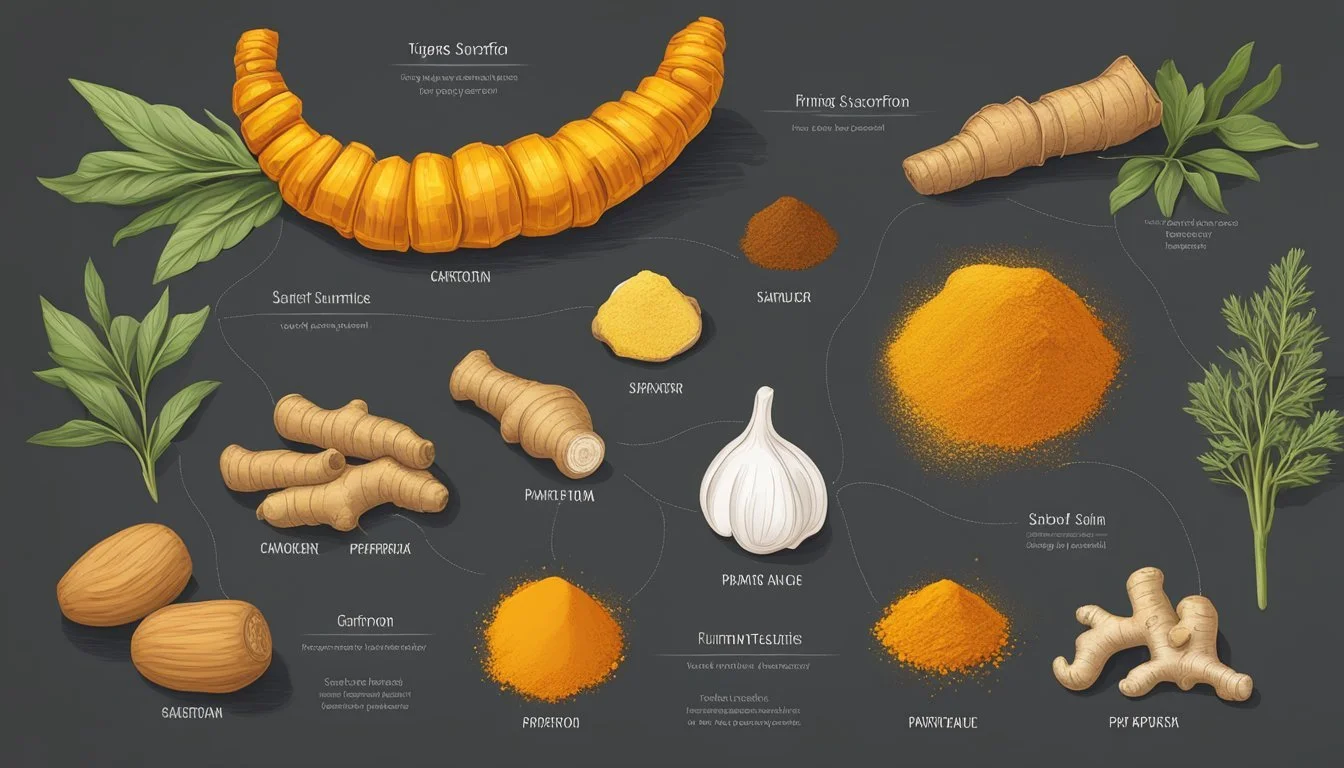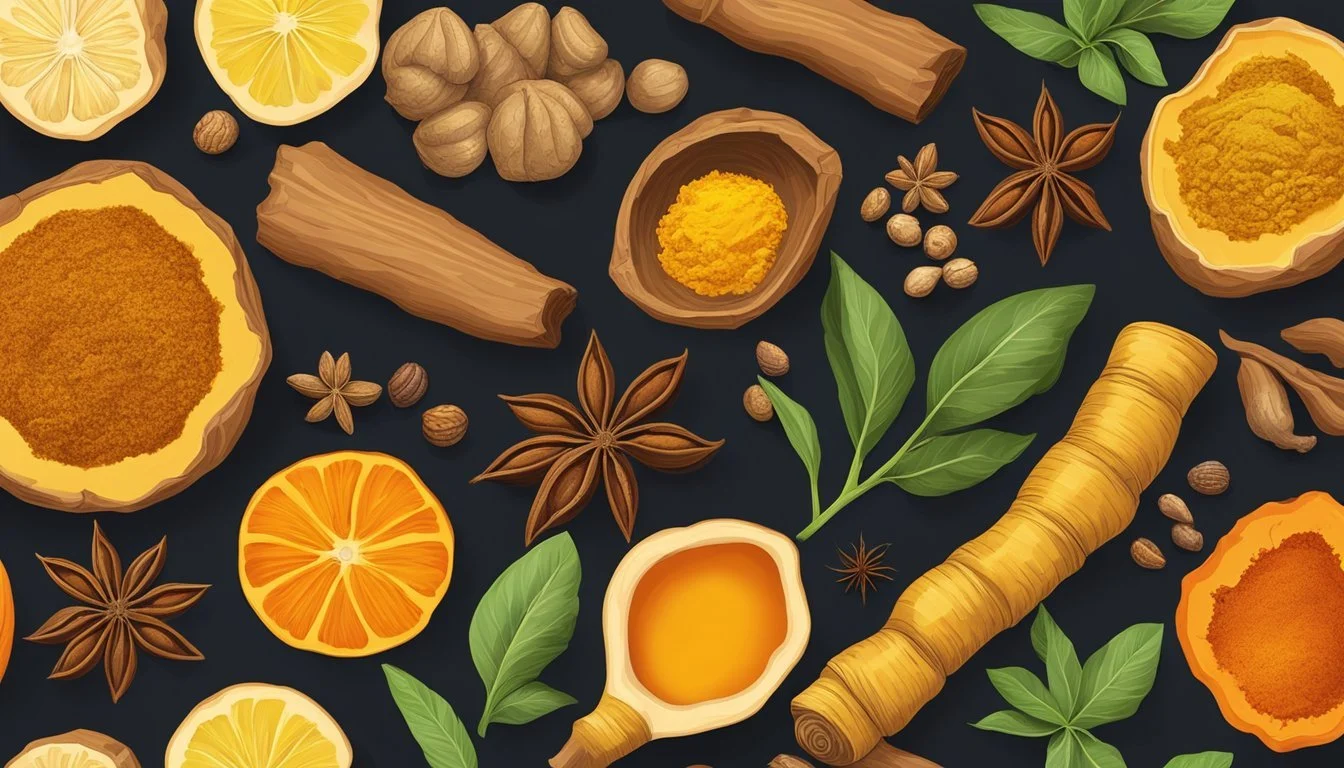Turmeric Substitutes
Top Alternatives for Your Spice Rack
Turmeric, a vibrant yellow spice, holds a prestigious place in the culinary world, renowned not only for its ability to impart a warm, distinctive flavor but also for its purported health benefits. It's derived from the root of the Curcuma longa plant and is a staple in many Asian dishes, especially in Indian cuisine. While turmeric is readily available in most grocery stores, there are instances when a suitable substitute is needed, whether for its earthy taste or its rich, golden hue.
When turmeric is unavailable or a different flavor profile is desired, several alternatives can be employed without compromising the dish's integrity. Substitutes such as cumin, curry powder, and ginger provide a semblance of turmeric's uniqueness, each bringing its own depth and character to a recipe. For color substitution, spices like saffron and annatto can offer a similar vibrant color palette. These alternatives are not only practical but also widely accessible, allowing for culinary experimentation and adaptation.
Understanding the potential replacements for turmeric ensures that chefs and home cooks alike can confidently navigate recipe adjustments. Each substitute comes with its own considerations regarding the ratio and manner of use to best mimic the role of turmeric in a dish. This knowledge is invaluable for anyone looking to explore the vast and varied world of spices without being bound by the availability of just one.
Understanding Turmeric
Turmeric is an integral spice in various cuisines and possesses a multitude of health benefits tied to its active compound, curcumin.
Culinary Uses of Turmeric
Turmeric is widely known for its vibrant golden color and earthy flavor. It's a staple in South Asian and Middle Eastern dishes, commonly used in:
Curries: Imparts a rich color and subtle flavor.
Rice: Offers a distinct yellow hue and warm aroma.
Marinades: Adds a piquant taste to meats and vegetables.
In cooking, one may also encounter turmeric in the form of turmeric paste or fresh turmeric. These forms can be used in varying proportions, usually a 1:1 ratio for turmeric paste and about 1 teaspoon of ground turmeric for every ½ inch of fresh turmeric.
Health Benefits of Turmeric
The health benefits of turmeric are largely attributed to curcumin, a potent antioxidant with powerful anti-inflammatory properties. Research indicates that curcumin may:
Mitigate inflammation, which is beneficial for managing conditions such as arthritis.
Act as an antioxidant, helping to protect the body from damage caused by free radicals.
It is important to note that the absorption of curcumin into the bloodstream is relatively low, but its efficacy can be increased when paired with piperine, found in black pepper.
Turmeric in Traditional Medicine
In traditional medicine, particularly in Ayurveda, turmeric holds a significant place as a medicinal herb. It has been used for centuries to treat various ailments due to its:
Therapeutic properties: Applied in the healing of wounds and bruises.
Detoxification: Believed to purify the blood and liver.
The application of turmeric in Ayurvedic practices often involves both topical and ingestible treatments, reflecting its versatility as a medicinal ingredient.
Identifying Appropriate Substitutes
When one needs to replace turmeric in a recipe, it is important to consider taste, flavor, color, and how the substitute will behave during cooking.
General Factors to Consider
In selecting an alternative for turmeric, one should assess taste, flavor profile, color, and cooking behavior. The chosen substitute should complement the other ingredients and not overpower them. The color, although secondary, is particularly important in certain dishes where turmeric is used for its vibrant hue.
Substitute Options Overview
Substitute Taste Overview Color Contribution Cooking Suitability Saffron Distinct and intense flavor; luxurious Offers a similar yellow color Best used in rice dishes and paellas Ground Cumin Earthy taste similar to turmeric Darker than turmeric Versatile, suitable for curries and stews Curry Powder Blend of spices, including turmeric Varies, usually yellowish Suitable for dishes needing complex flavors Mustard Seed Pungent and slightly spicy Adds a yellowish tone Works well in pickles, dressings, and marinades Paprika and Mace Paprika adds smokiness, mace adds a woodsy flavor Together yield a yellow-orange color Ideal for meat rubs and stews
Each substitute brings its own unique profile to a dish, and they should be selected based on the desired outcome in both flavor and appearance.
Popular Turmeric Substitutes
Finding a substitute for turmeric can be important in cases where its distinct color or flavor is desired in a dish but the ingredient is unavailable. The following alternatives have been identified as popular substitutes for both ground and fresh turmeric.
Ground Turmeric Alternatives
Curry Powder: A blend containing turmeric, curry powder can closely match the color and taste profile of turmeric. However, it generally includes additional spices like coriander, cumin, and chili pepper, which could alter the intended flavor of the recipe.
Mustard Powder: Offering a similar vibrant yellow hue, mustard powder serves as a ground turmeric alternative. Use a smaller quantity, as the flavor is more pungent.
Garam Masala: This warm spice mix features common components such as cumin, coriander, and cardamom. It has a different but pleasing flavor profile and can be used as an alternate to ground turmeric in a pinch.
Ginger Powder: Although lacking turmeric's color, ground ginger brings a warm, spicy flavor to dishes and can act as an alternative in terms of taste.
Fresh Turmeric Replacements
Fresh Ginger Root: For those seeking an alternative to fresh turmeric root, fresh ginger offers a comparable texture and a zingy flavor that can enhance a variety of recipes. It doesn't mimic the color, but the flavor profile can be similarly bold.
Galangal: Although less common, galangal is a rhizome like turmeric and ginger, and can be used when a fresher, more citric taste is suitable for the dish. It too does not provide turmeric's signature yellow tint.
These substitutes may not be perfect matches for every recipe, but they can provide suitable alternatives based on the needs of the dish, whether it be for flavor or color.
Specific Substitute Profiles
When cooking without turmeric, certain substitutes can replicate its flavor and color. Each substitute offers unique characteristics suited for different types of dishes.
Curry Powder As a Substitute
Curry powder, a blend of spices, includes turmeric as a key ingredient. It imparts a warm, complex flavor and golden hue to dishes. Madras curry powder provides a hotter taste profile, whereas standard curry powders are milder. One can utilize curry powder in a one-to-one ratio for turmeric to achieve a similar color and a slightly bolder taste.
Using Ginger for Its Zing
Ginger shares a botanical family with turmeric, offering a spicy zing and sharpness that can stand in for turmeric's more subtle flavor. Ground ginger is less earthy but still effective in providing a distinctive spice note, especially in recipes where the color of turmeric is not critical. It's often best to start with half the amount of turmeric called for and adjust to taste given ginger's potency.
Garam Masala's Complex Flavors
Garam Masala, a potent Northern Indian spice blend, boasts a nuttier taste due to its mix of cinnamon, cloves, cumin, and other spices. It can substitute for turmeric when a complex, aromatic flavor profile is desired. Its incorporation should be thoughtful and conservative, as it can be overpowering. Garam masala works exceptionally well in meat dishes and stews where robust flavors are essential.
Substitutes According to Dish Type
Selecting the right turmeric substitute depends heavily on the type of dish being prepared. Whether one is aiming for similar color or taste, each dish category may have distinct substitutes that work best.
Substitutes for Savory Dishes
For savory dishes such as curries, soups, and stews, substitutes that offer a depth of flavor and maintain the dish's color profile are preferred. Ground cumin is frequently recommended due to its earthy taste, though it should be used in half the quantity of turmeric to avoid overpowering the dish. A blend of mace and smoked paprika offers a complexity suitable for dishes where a woodsy flavor is desired. Meanwhile, curry powder can be directly used as it usually contains turmeric and preserves the intended spice blend of the recipe.
Curries & Stews: Use ground cumin at half the amount of turmeric.
Soups: A pinch of saffron can provide a similar yellow hue.
Stir-fries: Curry powder or a blend of mace and smoked paprika are useful for imbuing both color and flavor.
Alternatives for Sweet Dishes and Baked Goods
When it comes to sweet dishes and baked goods, where turmeric is less about taste and more about color, substitutes like annatto seeds are practical. They impart a vibrant color with a less pungent taste, making them suitable for rice dishes and subtle sweet treats. When preparing smoothies that call for turmeric primarily for its color and hint of flavor, ginger can serve as a fitting alternative due to its similar warm and spicy notes.
Rice Dishes: Annatto seeds can replace turmeric to achieve the yellow-orange color, using a 1:2 ratio with vegetable oil.
Baked Goods & Smoothies: Use ginger, applying a ratio depending on the desired flavor intensity.
Color and Flavor Adjustments
When seeking alternatives to turmeric spice, one must consider both the earthy flavor and vibrant color that turmeric imparts. The goal of substitutions is to achieve a balance that complements the dish without overpowering it.
Matching Turmeric's Earthy Tone
Turmeric has a distinctive earthy and slightly bitter flavor. To match this profile, ground ginger or cumin can be viable options, though they should be used cautiously due to their stronger taste. For example, to replace 1 tablespoon of turmeric powder:
Ground ginger: Use 3 teaspoons.
Ground cumin: Use 1 teaspoon, in combination with the ginger.
A blend of mace and smoked paprika may also introduce a similar savoriness and complexity. Mace offers a warm, slightly sweeter note whereas paprika provides a smokiness that can produce a depth akin to turmeric's earthiness.
Compensating for Turmeric's Color
Saffron and annatto seeds are excellent for replicating turmeric's vibrant yellow hue. They are, however, on the higher end of the cost spectrum and may introduce their own unique flavors to a dish.
Saffron: Use sparingly as it is potent and can impart a strong aroma and flavor.
Annatto seeds: These provide a bright yellowish-orange color, similar to turmeric, and should be ground and used in small amounts to avoid altering the dish's taste profile.
For a more economical choice, safflower petals or powder might not fully replicate the flavor but can achieve a similar color. To replace 1 teaspoon of turmeric:
Safflower: Use 1 teaspoon of petals or powder.
Paprika can also be used for its coloring ability, and will contribute a different taste profile that can complement a variety of dishes, especially when coloring is the primary concern, such as in yellow rice. However, one should adjust other spices accordingly to maintain the desired overall flavor of the dish.
Health-Oriented Substitutions
When seeking alternatives to turmeric, it is beneficial to consider substitutes that offer similar health advantages, such as anti-inflammatory properties and high antioxidant content.
Anti-Inflammatory Alternatives
Ginger is a powerful anti-inflammatory alternative that can emulate some of the health benefits of turmeric. Both turmeric and ginger belong to the same botanical family and have been shown to reduce inflammation, which is beneficial for conditions such as arthritis. Incorporating ginger into dishes can also help manage symptoms related to indigestion and nausea.
Black Pepper is often paired with turmeric to enhance absorption of curcumin, turmeric's key compound, due to a substance in black pepper called piperine. Although black pepper alone does not serve as a direct substitute for turmeric's color or flavor, its anti-inflammatory effects and the ability to increase the bioavailability of other healthful compounds should not be overlooked.
Antioxidant-Rich Substitutes
Antioxidants play a crucial role in protecting the body from oxidative stress and may contribute to mitigating the risk of chronic diseases. While turmeric is known for its high antioxidant content, there are other substitutes that can also contribute to a diet rich in antioxidants.
Golden Milk is a beverage that traditionally includes turmeric, but it can still be beneficial even when the turmeric is replaced or omitted. Enhancing golden milk with other antioxidant-rich spices, like cinnamon or cardamom, maintains its status as a healthful drink.
Depression management can benefit from antioxidant consumption. While turmeric is lauded for its potential role in alleviating depression, alternatives like saffron have also garnered attention for their mood-lifting properties. Saffron's rich antioxidant profile may make it a viable substitute in applications where the mood-stabilizing effects of antioxidants are desired.
By carefully selecting substitutes for turmeric, one can retain the health-oriented aspects of their meals without sacrificing the therapeutic potential of their ingredients.
Conclusion
Turmeric is renowned for its bold yellow hue and earthy flavor in dishes ranging from curries to soups. However, one can encounter situations when this spice is unavailable. There are several alternatives that not only mimic the color and taste of turmeric but also contribute their distinct profiles to recipes.
Notable turmeric substitutes include:
Saffron: For a similar color, saffron is an exquisite but expensive choice.
Annatto: Derived from achiote tree seeds, it provides a vibrant color.
Mustard Powder: It imparts a warm, pungent flavor and should be used sparingly.
Garam Masala: A blend of spices that complements a wide array of dishes.
When it comes to preparing healthy meals, these substitutes not only allow one to maintain a similar appearance and palate but also offer a variety of flavors and nutritional values. Cooks can choose from these options based on availability and the desired outcome of the recipe. For an elaborate essence, garam masala might be the right pick, while for simplicity, paprika could suffice.
It is recommended to start with conservative quantities when using these substitutes, as their potency and flavor profile can differ from turmeric. Experimenting with these alternatives could lead to discovering new favorites that may become staples in one's spice cabinet.








